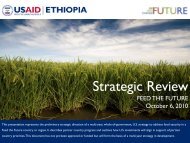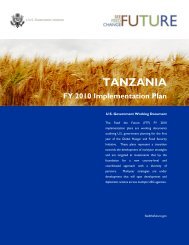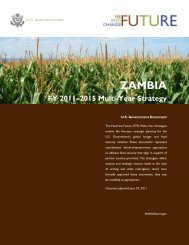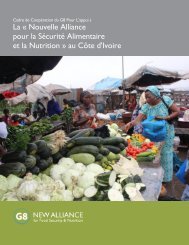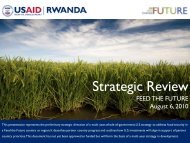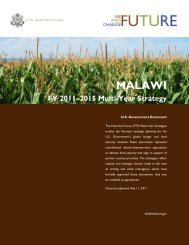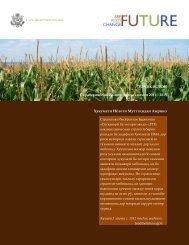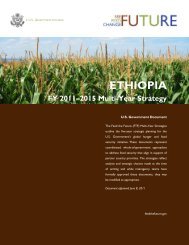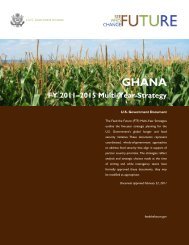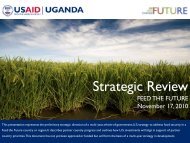Bangladesh Country Investment Plan - Feed the Future
Bangladesh Country Investment Plan - Feed the Future
Bangladesh Country Investment Plan - Feed the Future
Create successful ePaper yourself
Turn your PDF publications into a flip-book with our unique Google optimized e-Paper software.
7. RESULTS FRAMEWORK<br />
7.1 The Results Framework defines what <strong>the</strong> country wants to achieve through <strong>the</strong> CIP in<br />
terms of national food security goals, and how <strong>the</strong> country wants to achieve <strong>the</strong>m in terms of<br />
investment. As mentioned by WFP and <strong>the</strong> WB during <strong>the</strong> CIP forum on 20 March 2011, <strong>the</strong><br />
result framework is key tool for alignment and coordination when, as proposed here, it is linked<br />
with operational activities and projects. The CIP result framework is made of a three-level<br />
Results Chain, which defines <strong>the</strong> CIP Expected Outcomes/Impacts, Outputs and Inputs.<br />
7.2 The identified Results are coherent with relevant key national strategic documents,<br />
such as <strong>the</strong> National MDGs, <strong>the</strong> National Food Policy (NFP) and <strong>the</strong> 6 th FYP, and fur<strong>the</strong>r build on<br />
<strong>the</strong> findings of <strong>the</strong> CIP prioritization and costing exercises. They are coherent and logically linked<br />
to each ano<strong>the</strong>r and include <strong>the</strong> following three levels 1 :<br />
• Outcomes/Impact level: 3 expected outcomes/impacts from <strong>the</strong> 3 CIP components<br />
have been formulated; <strong>the</strong>se correspond to <strong>the</strong> three objectives of <strong>the</strong> National<br />
Food Policy <strong>Plan</strong> of Action.<br />
• Output Level: at output level a distinction between aggregate outputs and sub<br />
outputs has been made. The aggregate outputs are linked to each of <strong>the</strong> 12<br />
programs of <strong>the</strong> CIP; each program of <strong>the</strong> CIP however has sub-outputs (40)<br />
which refer to specific and prioritized areas for investments. The output level of<br />
<strong>the</strong> CIP is comparable to <strong>the</strong> level of <strong>the</strong> 26 areas of Interventions of <strong>the</strong> National<br />
Food Policy <strong>Plan</strong> of Action.<br />
• Input Level: to each of <strong>the</strong> 12 CIP programs and 40 areas of investment at input<br />
level, correspond a number of specific projects. The monitoring of CIP at input<br />
level represents <strong>the</strong> financial execution of <strong>the</strong> projects and Government and donor<br />
commitment, aggregated in <strong>the</strong> respective area of intervention and CIP program.<br />
1 In this document, <strong>the</strong> terms used for <strong>the</strong> monitoring have not followed <strong>the</strong> United Nations Evaluation Group (UNEG) terminology. Indeed,<br />
emphasis has been given to coherence with existing strategic documents and particularly with <strong>the</strong> NFP PoA and its first Monitoring Report,<br />
Indeed, both <strong>the</strong> CIP and <strong>the</strong> NFP PoA (2011) will be monitored toge<strong>the</strong>r. It is thus essential that same terms refer to <strong>the</strong> same monitoring<br />
level for <strong>the</strong> sake of clarity.<br />
17



